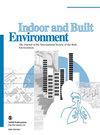探索使用二氧化碳作为呼出微粒的替代物来预测室内病原体暴露风险的可能性
IF 2.9
3区 工程技术
Q2 CONSTRUCTION & BUILDING TECHNOLOGY
引用次数: 3
摘要
空气传播已被确认为SARS-CoV-2的三种主要传播途径之一。因此,为了减少SARS-CoV-2在室内的传播,了解人类呼吸中存在的呼吸道飞沫(或气溶胶)的分布似乎很重要。为了研究CO2浓度是否可以作为占用空间中存在的呼出颗粒数量的代表,在教室环境中监测了6名健康受试者不同直径(0.3、0.5、1.0、2.5、5.0和10 μm)颗粒和CO2浓度的分布。此外,还分别测量了6名健康受试者呼吸中相同大小的颗粒物的数量。结果表明:(1)与CO2相反,室内颗粒物的主要来源是室外空气,而不是人体本身;(2)不同通风方式对室内颗粒物数量的影响不同于对CO2浓度的影响;(3)室内颗粒物数量与CO2浓度之间几乎无显著关系。基于这些结果,本研究因此不能得出结论,教室里的二氧化碳浓度可以作为居住者呼出颗粒数量的代表。本文章由计算机程序翻译,如有差异,请以英文原文为准。
Exploring the possibility of using CO2 as a proxy for exhaled particles to predict the risk of indoor exposure to pathogens
Airborne transmission has been confirmed as one of three principal ways of SARS-CoV-2 transmission. To reduce the transmission of SARS-CoV-2 indoors, understanding the distribution of respiratory droplets (or aerosols) present in human breath seems therefore important. To study whether the CO2 concentration can be used as a proxy for the number of exhaled particles present in an occupied space, the distribution of particles with different diameters (0.3, 0.5, 1.0, 2.5, 5.0 and 10 μm) and CO2 concentrations were monitored in a classroom setting with six healthy subjects. Additionally, numbers of particles with the same sizes were measured in the breath of the same six healthy subjects separately. Results showed that (1) on the contrary to CO2, the main source of indoor particles came from outdoor air, and not from occupants; (2) the impacts of ventilation regimes on indoor particle numbers were different to the impacts on CO2 concentrations; and (3) almost no significant relationship between the number of indoor particles and CO2 concentration was observed. Based on these results, this study could therefore not conclude that the CO2 concentration in a classroom can be used as a proxy for the number of exhaled particles by the occupants.
求助全文
通过发布文献求助,成功后即可免费获取论文全文。
去求助
来源期刊

Indoor and Built Environment
环境科学-工程:环境
CiteScore
6.40
自引率
25.00%
发文量
130
审稿时长
2.6 months
期刊介绍:
Indoor and Built Environment publishes reports on any topic pertaining to the quality of the indoor and built environment, and how these might effect the health, performance, efficiency and comfort of persons living or working there. Topics range from urban infrastructure, design of buildings, and materials used to laboratory studies including building airflow simulations and health effects. This journal is a member of the Committee on Publication Ethics (COPE).
 求助内容:
求助内容: 应助结果提醒方式:
应助结果提醒方式:


